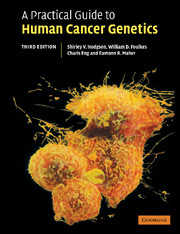Book contents
- Frontmatter
- Contents
- Dedication
- Preface
- Acknowledgements
- Part one Cancer genetic counselling
- Part two Genetics of human cancers by site of origin
- 2 Central nervous system
- 3 Eye
- 4 Cardiorespiratory system and thorax
- 5 Endocrine system
- 6 Gastrointestinal system
- 7 Reproductive system
- 8 Urinary system
- 9 Blood and lymph
- 10 Musculoskeletal system
- 11 Skin
- Part three Cancer-predisposing syndromes
- Appendix
- References
- Index
9 - Blood and lymph
Published online by Cambridge University Press: 20 August 2009
- Frontmatter
- Contents
- Dedication
- Preface
- Acknowledgements
- Part one Cancer genetic counselling
- Part two Genetics of human cancers by site of origin
- 2 Central nervous system
- 3 Eye
- 4 Cardiorespiratory system and thorax
- 5 Endocrine system
- 6 Gastrointestinal system
- 7 Reproductive system
- 8 Urinary system
- 9 Blood and lymph
- 10 Musculoskeletal system
- 11 Skin
- Part three Cancer-predisposing syndromes
- Appendix
- References
- Index
Summary
Leukaemia
Leukaemia is responsible for approximately 2 per cent of all cancers, with an incidence of about 8 per 100 000 in the UK. Acute myeloid and lymphoblastic leukaemias (AML and ALL) account for about 1 per cent of all cancers and 1.5 per cent of cancer deaths. The age incidence of leukaemia shows two peaks, in childhood and in the elderly. Genetic factors are not considered to have a prominent role in the pathogenesis of acute leukaemias or in chronic myeloid leukaemia, but have been implicated in chronic lymphocytic leukaemia (CLL). Gunz et al. (1975) studied the incidence of leukaemia in relatives of 909 patients with leukaemia. The overall incidence of leukaemia in first-degree relatives was three times higher than expected although only 2 per cent of patients had a first-degree relative with leukaemia. Among the main subtypes of leukaemia, an increased risk to relatives was most marked in chronic lymphocytic leukaemia, less so in acute leukaemias and absent in chronic myeloid leukaemia. When familial clusters of leukaemia have been reported, the type of leukaemia in individual relatives is not always concordant (Lee et al., 1987). Familial leukaemia does not necessarily indicate a genetic cause, and shared exposure to an environmental leukaemogen also needs to be considered, particularly in childhood acute leukaemias. Genetic disorders that have been associated with a predisposition to leukaemia are shown in Table 9.1 and discussed in detail in part three. Genetic disorders are thought to account for only 3 per cent of childhood leukaemia.
- Type
- Chapter
- Information
- A Practical Guide to Human Cancer Genetics , pp. 120 - 131Publisher: Cambridge University PressPrint publication year: 2006

